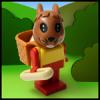53 members have voted
-
1. How do you rate this set?
-
Poor1
-
Below Average1
-
Average5
-
Above Average16
-
Outstanding30
-
-
2. Which is the better set: Camel or Baron?
-
3451 Sopwith Camel20
-
10024 Red Baron16
-
I can't decide - they're both great!15
-
Meh - neither floats my boat, so to speak.2
-
-
Recently Browsing 0 members
No registered users viewing this page.

